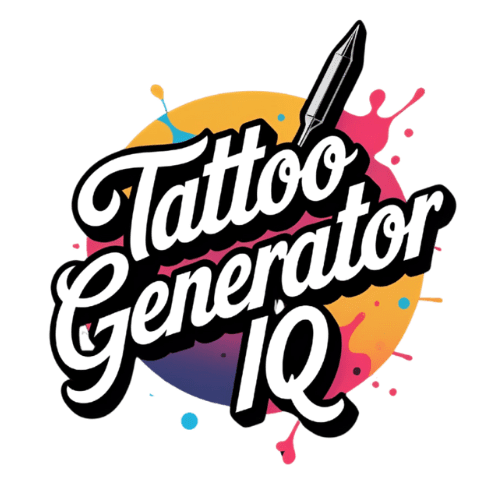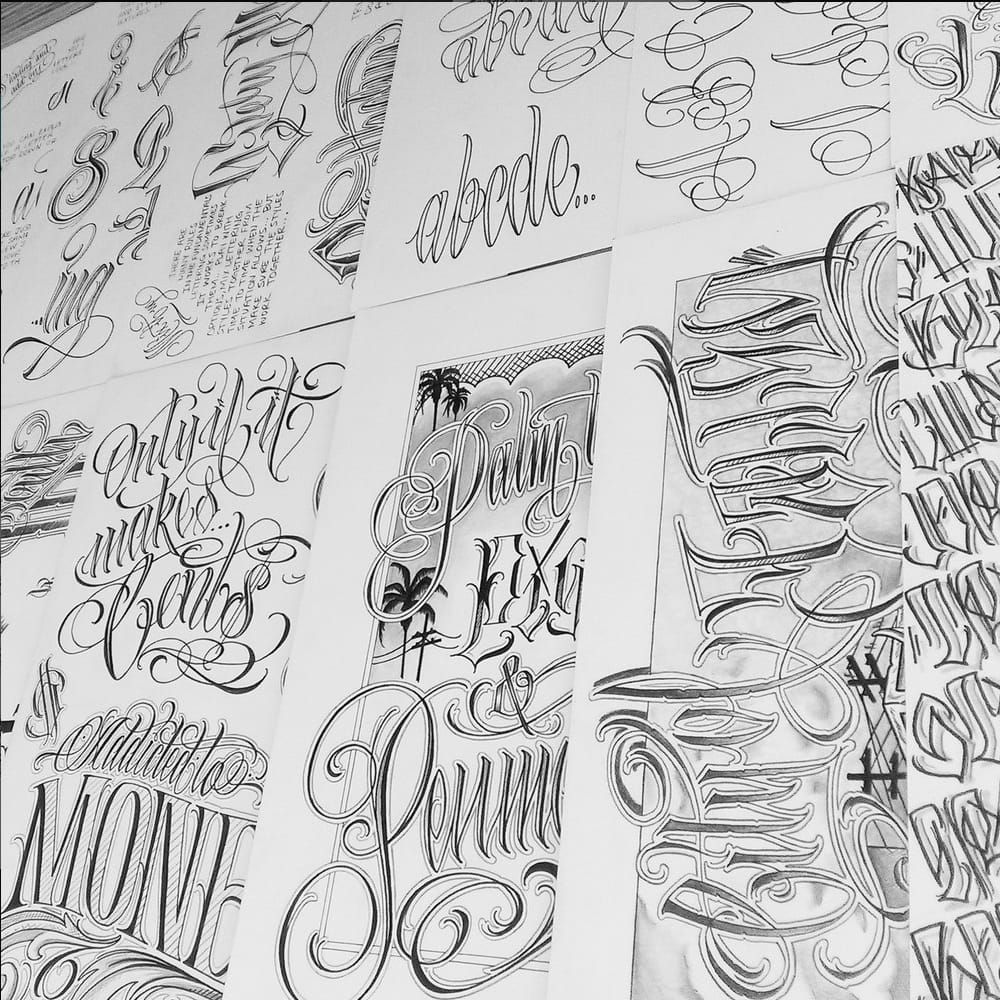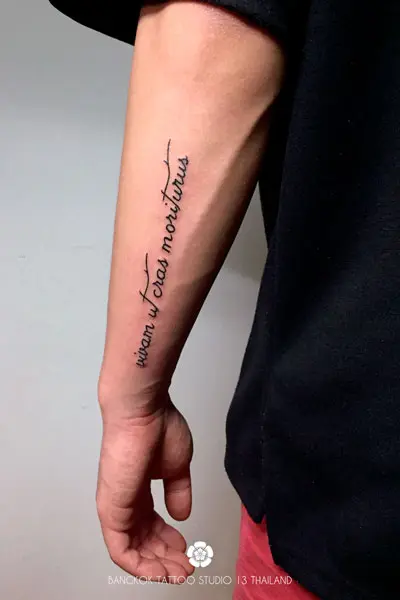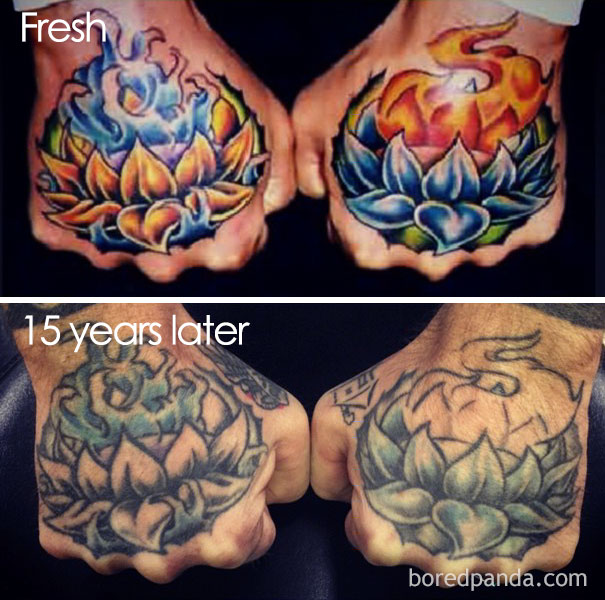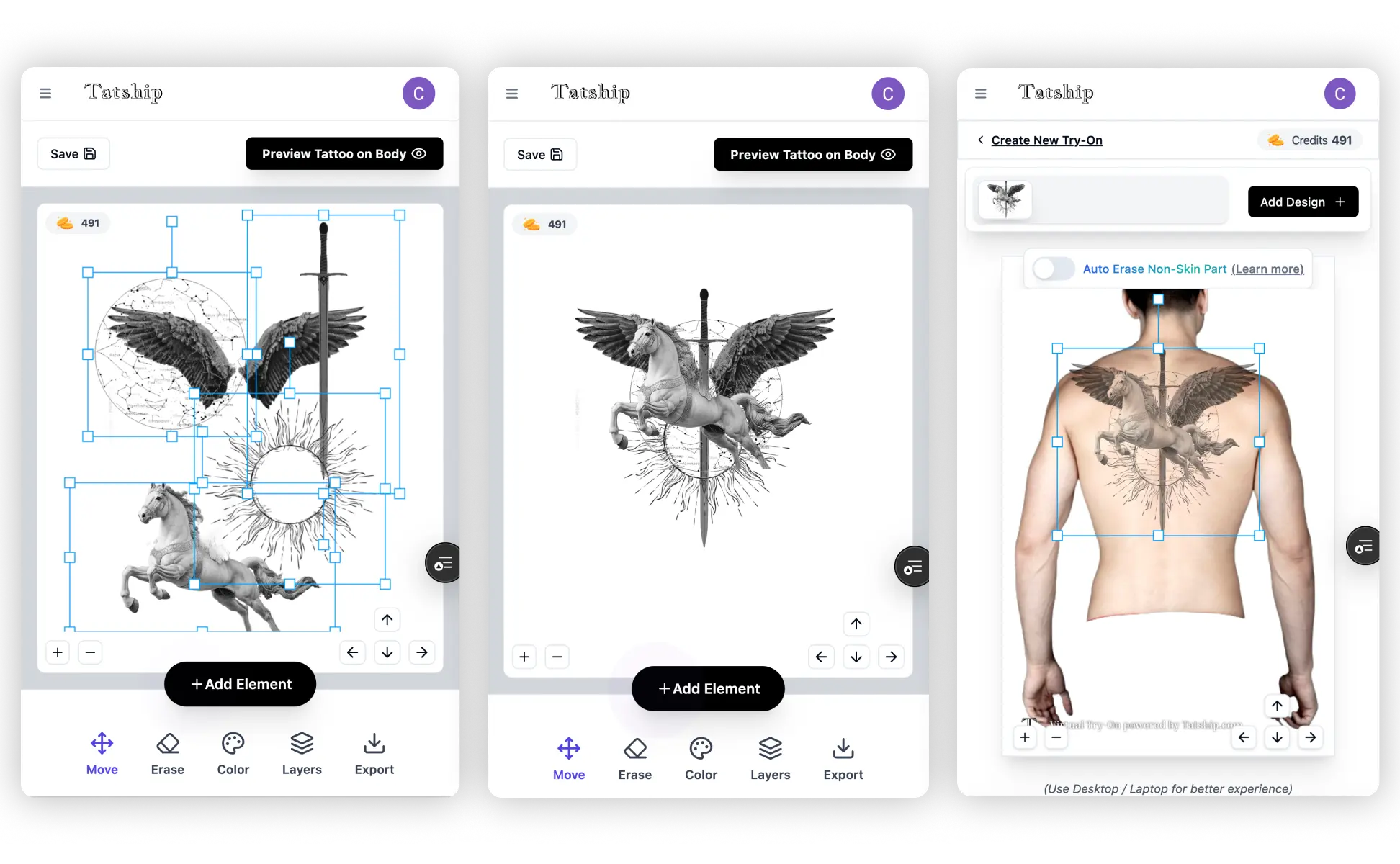25 Last Name Tattoo Ideas That’ll Make Your Family Heritage Shine
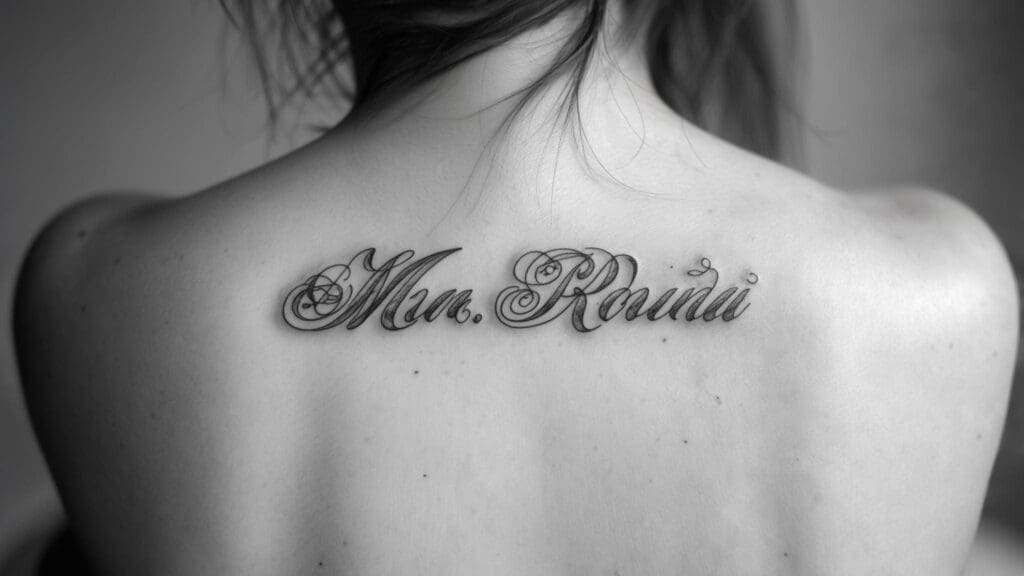
Name tattoos remain one of the most popular tattoo choices, with many people loving their name tattoos just as much decades later as they did the day they got them. I remember when my cousin got our family name tattooed across his forearm – watching him beam with pride every time someone asked about it made me realize how powerful these personal tributes can be.
Your last name carries generations of history, stories, and identity. Getting it permanently inked isn’t about the letters themselves – it’s about honoring your roots while expressing your personal style.
Source: pinimg.com
Table of Contents
- Essential Considerations Before Getting Your Last Name Tattoo
- Classic Typography Styles
- Cultural and Heritage-Inspired Designs
- Nature and Symbolic Integration
- Modern Artistic Approaches
- Placement-Specific Designs
- Design Analysis and Longevity
- Professional and Budget Considerations
- Bringing Your Vision to Life
- Final Thoughts
TL;DR
- Font choice dramatically impacts your tattoo’s readability and aging – script looks elegant but may blur, while bold letters ensure longevity
- Placement affects visibility, pain level, and professional impact – forearms offer moderate pain with good visibility, while backs provide more canvas space
- Cultural designs require respectful research and skilled artists to avoid appropriation while honoring heritage authentically
- Nature-integrated designs age gracefully due to organic imperfections but may sacrifice some readability for artistic impact
- Modern techniques create stunning visuals but require frequent touch-ups and premium artists
- Budget ranges from $500-2000 depending on complexity, with simple typography being most affordable and elaborate cultural work costing most
- AI design tools help visualize concepts before committing to permanent ink, reducing regret and ensuring satisfaction
Essential Considerations Before Getting Your Last Name Tattoo
Before diving into design options, you need to evaluate six critical factors that will determine your last name tattoo’s success and longevity. Font selection impacts both aesthetics and readability over time, while placement affects visibility, pain levels, and professional implications. Personal meaning connects your last name tattoo to family heritage, but you must also consider how the design will age and what budget you’ll need for quality work.
Font choice creates the foundation of your entire design – script fonts offer elegance but thin lines may blur over 10-15 years, while bold letters ensure readability but might lack personal character. I’ve seen too many beautiful script last name tattoos turn into illegible smudges because the owner didn’t consider long-term aging.
Placement determines three key outcomes: daily visibility for personal enjoyment, pain tolerance during the tattooing process, and professional acceptability in your career field. Your forearm might seem perfect for showing off your family name, but will your boss feel the same way?
Font and Typography Impact
Your font choice creates the foundation for your entire tattoo’s visual appeal and determines how well it will age over time. Script fonts deliver elegance through flowing curves but risk blurring as thin lines spread, while block letters guarantee decades of clarity at the expense of decorative charm.
When exploring different lettering styles for your last name tattoos, consider using our cursive tattoo font generator to visualize how flowing script will look with your specific surname before making any permanent decisions.
Serif fonts include small decorative strokes that can blur together over time, requiring thicker base strokes to maintain long-term readability. I’ve worked with clients who chose delicate serif fonts only to return five years later frustrated that their beautiful last name tattoo had become difficult to read.
Letter spacing becomes critical with decorative fonts – too tight creates illegible clusters, while too loose destroys the design’s visual cohesion. The sweet spot requires careful planning and an experienced artist who understands typography principles.
| Font Style | Readability (Years) | Pain Level | Best For | Aging Quality |
|---|---|---|---|---|
| Script/Cursive | 10-15 years | Low-Medium | Longer names, feminine aesthetic | Requires touch-ups |
| Bold Block | 20+ years | Medium | Short names, masculine look | Excellent longevity |
| Gothic/Medieval | 15-20 years | Medium | Traditional surnames | Good with proper line weight |
| Sans-Serif Modern | 20+ years | Low | Professional settings | Excellent, minimal maintenance |
| Hand-lettered | 15-20 years | Medium-High | Unique personal style | Variable, artist-dependent |
Source: pinimg.com
Placement Strategy and Pain Management
Location selection affects three crucial factors: how often you’ll see and enjoy your tattoo, the discomfort level during application, and potential career implications. Popular name tattoo on forearm placement offers moderate pain with excellent visibility, while back locations provide larger canvases but limit personal viewing.
Understanding pain levels is crucial when choosing your forearm last name tattoo placement, and our comprehensive tattoo pain chart breaks down exactly what to expect from different body areas to help you make an informed decision.
Bone proximity increases pain intensity – ribcage and wrist locations register 7-9 on pain scales, while forearms and shoulders stay in the 4-6 range. Your pain tolerance matters, but so does the session length required for your chosen design.
Muscle movement affects healing and long-term appearance – areas with frequent flexing may experience slower healing and require touch-ups sooner. That name tattoo on forearm might heal beautifully, but a wrist placement could face daily stress from constant hand movement.
Sarah, a marketing professional, chose her Italian surname “Benedetti” in elegant script along her collarbone. The horizontal placement allows her to showcase it with open necklines while easily concealing it with professional attire. The moderate pain level (5/10) made the 2-hour session manageable, and the location’s minimal muscle movement ensures optimal healing and longevity.
Personal Heritage Integration
Your surname carries generational stories that can be honored through thoughtful design elements reflecting cultural background, family achievements, or geographic origins. This deeper meaning transforms simple text into powerful personal statements that connect you to your ancestral roots.
Family research often reveals cultural symbols or geographic elements that can be authentically incorporated without appropriating other cultures. I encourage clients to dig into their family history – you might discover meaningful elements that make your last name tattoo truly unique.
Personal achievements or family trades can inspire decorative elements that add layers of meaning beyond the surname itself. Maybe your family has a history of carpentry, military service, or artistic pursuits that could enhance your design.
Aging and Maintenance Realities
Tattoo aging depends on design complexity, placement location, and skin care habits. Simple designs with thick lines age gracefully for decades, while intricate details and color work require periodic touch-ups to maintain their original impact and clarity.
Sun exposure accelerates fading and line blurring – tattoos in frequently exposed areas need more diligent UV protection throughout their lifetime. Your forearm last name tattoo will face more sun damage than one hidden under clothing.
Skin elasticity changes affect tattoo appearance over time, with weight fluctuations and aging causing stretching or compression of the original design. This reality doesn’t mean you shouldn’t get your last name tattoo – just plan accordingly.
Professional Environment Assessment
Career considerations vary dramatically across industries and geographic regions. Conservative fields often require concealable placements, while creative industries increasingly embrace visible body art as personal expression.
Company policies on visible tattoos continue evolving, but permanent decisions should consider long-term career flexibility rather than current workplace acceptance. What’s acceptable today might change with new management or career moves.
Geographic location influences professional tattoo acceptance – urban areas typically show more tolerance than rural or conservative regions. Consider where you might live and work in the future, not just your current situation.
Investment and Artist Selection
Quality last name tattoos require skilled artists specializing in lettering work, with costs ranging from $500 for simple designs to $2000+ for elaborate cultural pieces. Artist expertise directly impacts both initial results and long-term satisfaction with your investment.
Before committing to your last name tattoo, research realistic pricing expectations with our detailed tattoo cost guide which breaks down factors that influence final pricing beyond just size and complexity.
Portfolio review should focus specifically on lettering samples rather than general tattoo work – script and typography require specialized skills different from illustration. I’ve seen too many last name tattoos ruined by artists who excel at portraits but struggle with clean lettering.
Consultation fees often apply toward final tattoo costs and allow discussion of technical approaches, realistic timelines, and aftercare requirements. Don’t skip this step – it’s your chance to ensure you and your artist are on the same page.
Source: tattoodo.com
Classic Typography Styles
Typography forms the backbone of any last name tattoo. These timeless approaches focus on the beauty of letterforms themselves, ensuring your family name remains the star of the design.
1. Traditional Script Elegance
Flowing cursive lettering with decorative flourishes creates timeless sophistication for your family name. This style works beautifully for longer surnames and offers connecting letters with ornate capitals that add visual interest without overwhelming the text.
Cursive lettering requires expert spacing and flow to maintain readability – each letter must connect naturally while preserving individual character recognition. I’ve seen gorgeous script last name tattoos become illegible messes when artists don’t understand proper letter connections.
Decorative flourishes should complement your name’s natural rhythm rather than compete with it, with ornate capitals serving as anchor points for the overall composition. The key is restraint – too many flourishes turn elegant script into chaotic scribbles.
Source: pinimg.com
2. Bold Gothic Lettering
Medieval-inspired fonts feature thick, angular strokes with dramatic serifs that create powerful visual impact. This style works perfectly for names with strong consonants and appeals to those wanting bold statement pieces that command attention.
For authentic medieval aesthetics in your last name tattoos, explore our specialized gothic font generator which creates historically accurate letterforms that capture the power and tradition of this timeless style.
Gothic letterforms rely on consistent stroke width and angular geometry to maintain their medieval character – inconsistent line weight destroys the style’s authenticity. Every stroke needs to follow traditional proportions to achieve that authentic medieval look.
The dramatic nature of gothic fonts makes them ideal for shorter surnames where each letter can receive adequate space for proper detail execution. Cramming a long name into gothic lettering often results in compromised readability.
3. Modern Minimalist Sans-Serif
Clean, contemporary fonts without decorative elements emphasize simplicity and clarity above all else. This approach works ideally for shorter names and appeals to those prioritizing professional acceptability and long-term readability.
Sans-serif fonts depend entirely on letter spacing and proportion for visual appeal – without decorative elements, any spacing errors become immediately apparent. The minimalist approach demands perfection since there’s nowhere to hide mistakes.
The minimalist approach requires perfect execution since there are no flourishes or decorative elements to mask imperfections in the basic letterforms. Your artist’s technical skill becomes absolutely critical with these deceptively simple designs.
4. Vintage Americana Typography
1950s-inspired lettering reminiscent of classic signage and advertisements brings nostalgic charm to family names. This style particularly suits surnames that evoke traditional American trades and appeals to those wanting retro aesthetic appeal.
Americana typography captures specific historical periods through careful attention to letter proportions and decorative elements that defined mid-century design. Getting the proportions wrong makes the whole design feel off.
The nostalgic appeal works best when the chosen font period aligns with your family’s American heritage timeline or personal aesthetic preferences. There’s something satisfying about connecting your family name to a specific era of American design.
5. Hand-Lettered Calligraphy
Custom calligraphy appears hand-written and offers unique character variations that make each letter distinctly personal. This approach suits any name length while providing completely personalized aesthetics that can’t be replicated.
Hand-lettered designs require artists skilled in both traditional calligraphy and tattoo application – the translation from paper to skin demands specific technical adjustments. Not every tattoo artist can pull off convincing hand-lettered work.
Each letter receives individual attention for character variation while maintaining overall design cohesion, creating truly one-of-a-kind results that reflect personal handwriting styles. Your last name tattoo becomes as unique as your actual signature.
Source: shopify.com
Cultural and Heritage-Inspired Designs
Your family’s cultural background offers rich design possibilities that honor ancestral traditions while creating meaningful personal statements. These approaches require careful research and cultural sensitivity.
6. Celtic Knotwork Integration
Last names woven through traditional Celtic knots create intricate designs perfect for Irish surnames. This complex approach requires 3-4 hours across multiple sessions and demands artists experienced in authentic Celtic patterns to avoid cultural misrepresentation.
When incorporating Celtic elements into your last name tattoo, our Celtic font generator helps you explore authentic knotwork patterns and traditional lettering styles that honor Irish heritage while maintaining readability.
Authentic Celtic knotwork follows specific mathematical patterns and symbolic meanings – random interwoven lines don’t constitute genuine Celtic design. I’ve seen too many “Celtic” last name tattoos that are just random squiggles with no cultural authenticity.
The integration process requires balancing letter readability with knot complexity, often using Trinity knots as anchor points while maintaining continuous interwoven flow. Getting this balance right separates authentic Celtic work from generic tribal patterns.
Source: npr.org
Michael O’Sullivan wanted to honor his Irish heritage with his surname tattoo. Working with a Celtic art specialist, they wove “O’Sullivan” through an authentic Trinity knot pattern, with each letter following traditional knotwork flow. The design took 4 hours across two sessions, but the result beautifully balances cultural authenticity with personal meaning, creating a piece that honors his ancestry while remaining clearly readable.
7. Japanese Kanji Translation
Your surname translated into Japanese characters with traditional brushstroke styling offers striking visual appeal regardless of your heritage. This approach requires collaboration with language experts to ensure accurate translation and cultural respect.
Proper kanji translation focuses on meaning rather than phonetic sound – your surname’s etymology determines appropriate character selection for authentic representation. Don’t just pick characters that sound similar – that’s how you end up with embarrassing mistranslations.
Traditional brushstroke techniques must be adapted for tattoo application while maintaining stroke order and proportional relationships that define authentic Japanese calligraphy. The flowing nature of brush strokes creates beautiful last name tattoos when executed properly.
8. Ornate Victorian Flourishes
Elaborate decorative elements surrounding your name feature roses, scrollwork, and baroque details popular during the Victorian era. This approach creates stunning elaborate pieces but requires significant time investment and larger placement areas.
Victorian ornamentation follows specific design principles of symmetry and natural motifs – random decorative elements don’t capture the era’s authentic aesthetic. The Victorian style has rules, and following them makes the difference between elegant and gaudy.
The elaborate nature requires careful planning to ensure decorative elements enhance rather than overwhelm the central name text. Your last name should remain the focal point, not get lost in ornamental chaos.
9. Native American-Inspired Elements
Incorporating feathers, dreamcatchers, or geometric patterns honors indigenous artistic traditions when approached respectfully. This style requires extensive research into cultural significance to avoid appropriation while creating meaningful tributes.
Each Native American symbol carries specific tribal meanings and sacred significance – generic “tribal” patterns often misrepresent authentic indigenous art. Cultural appropriation is a real concern here, so do your homework before incorporating these elements into your last name tattoos.
Respectful incorporation requires understanding the cultural context and ensuring your design honors rather than exploits indigenous artistic traditions. When done right, these elements can create powerful connections to American heritage.
10. Latin Script with Roman Elements
Classical Roman lettering with architectural elements creates elegant designs perfect for names with Latin origins. This approach offers professional acceptability while honoring Western cultural roots through columns, laurel wreaths, and classical proportions.
Roman letterforms follow specific proportional relationships based on classical architecture – these mathematical ratios create the style’s timeless appeal. The Romans knew what they were doing with typography, and their principles still work today.
Architectural elements should complement rather than compete with the lettering, using classical motifs as framing devices. A subtle column or laurel wreath can elevate your last name tattoo without overwhelming the text.
Source: bkktattoostudio13.com
Nature and Symbolic Integration
Natural elements create powerful connections between your family name and the world around you. These designs often age gracefully due to their organic imperfections.
11. Floral Border Designs
Last names surrounded by roses, cherry blossoms, or family-significant flowers create garden-like frames around your text. This approach offers feminine appeal and seasonal symbolism but may require color work that fades faster than traditional black ink.
Drawing inspiration from nature for your last name tattoo design, explore our comprehensive floral tattoo guide which showcases how different flower types can complement and enhance surname lettering while adding personal meaning.
Floral selection should reflect personal or family significance rather than random aesthetic choices – each flower carries specific symbolic meanings. Roses mean something different than cherry blossoms, and your choice should connect to your family story.
Color integration requires understanding how different pigments age in skin, with some colors fading significantly faster than others over time. Beautiful colored flowers can turn muddy if you don’t plan for long-term color retention.
12. Tree Branch Typography
Letters formed from or intertwined with tree branches symbolize family roots and growth patterns. This approach works particularly well for names with nature connections and creates powerful family symbolism that ages gracefully.
Authentic branch formation requires studying actual tree growth patterns to ensure realistic organic flow and natural imperfections. Fake-looking branches destroy the natural aesthetic you’re trying to achieve.
The organic nature allows for custom sizing flexibility while maintaining readability through careful balance of natural texture and letter clarity. Your last name can grow naturally through the branches while remaining perfectly readable.
Source: pinimg.com
13. Mountain Range Silhouettes
Names positioned above or integrated into mountain skylines appeal to outdoor enthusiasts and those with geographic connections. This horizontal orientation provides masculine appeal but may limit placement options due to its directional requirements.
Mountain silhouettes should reflect actual geographic locations meaningful to your family rather than generic peak shapes. Why use random mountains when you could honor the actual peaks where your family has history?
The horizontal nature requires careful placement consideration to ensure the design works with your body’s natural lines and proportions. Not every body area works well with horizontal designs.
14. Ocean Wave Integration
Flowing wave patterns that incorporate lettering create dynamic movement ideal for coastal families or water-related surnames. This approach requires skilled shading work to achieve realistic wave effects and natural flow.
Realistic wave rendering demands understanding of water physics and light reflection to create convincing three-dimensional effects. Flat, cartoon waves won’t give you the dynamic movement you’re looking for.
The flowing nature must be balanced with letter readability, ensuring the wave movement enhances rather than obscures the text. Your last name tattoo should ride the wave, not get swallowed by it.
15. Constellation Mapping
Your surname written in stars or incorporated into actual constellation patterns combines astronomy with personal identity. This approach offers scientific accuracy and personal meaning but may be difficult to read from a distance.
Authentic constellation mapping requires astronomical accuracy and proper star positioning based on actual celestial coordinates. Random star patterns don’t capture the wonder of real constellations.
The stellar approach must balance scientific authenticity with practical readability, often requiring creative interpretation of star patterns. Your last name tattoos can literally reach for the stars while staying grounded in reality.
Source: squarespace-cdn.com
Modern Artistic Approaches
Contemporary design techniques offer cutting-edge aesthetics that push traditional tattoo boundaries. These approaches often require specialized artists and premium pricing.
16. Geometric Frame Designs
Last names enclosed in hexagons, triangles, or other geometric shapes offer contemporary appeal with clean lines. This approach provides excellent aging characteristics due to bold lines but may look dated as design trends evolve.
Geometric precision requires mathematical accuracy in angles and proportions – hand-drawn approximations destroy the style’s clean aesthetic. Perfect geometry demands technical precision that not every artist can deliver.
The contemporary appeal depends on current design trends, making long-term aesthetic relevance a consideration for permanent body art. What looks cutting-edge today might feel dated in a decade.
17. Watercolor Splash Backgrounds
Names in bold lettering with artistic watercolor effects create painting-like appearances on skin. This technique demands specialists in color blending but requires frequent touch-ups as watercolor effects fade quickly.
Watercolor effects require specific needle configurations and diluted ink applications to achieve authentic paint-bleeding appearances. The technique is more complex than it looks and demands specialized skills.
The artistic technique demands annual touch-ups to maintain color vibrancy, making it a higher-maintenance option than traditional black ink work. Beautiful watercolor last name tattoos come with ongoing maintenance commitments.
Source: thehonorablesociety.com
18. 3D Shadow Effects
Letters designed to appear three-dimensional with realistic shadows create dramatic visual impact perfect for photography. This technique requires master-level shading expertise and careful light source mapping for convincing dimensional illusion.
Dimensional illusion requires understanding light physics and shadow casting to create convincing three-dimensional effects on flat skin surfaces. Getting the shadows wrong makes the whole effect fall flat.
The technique works best with block letters rather than script fonts, as complex letterforms make shadow mapping extremely difficult. Your last name tattoo can literally pop off your skin when executed properly.
19. Negative Space Techniques
Designs where names appear cut out of larger images create sophisticated visual interest that ages well. This approach requires precise execution and may sacrifice some readability for artistic impact.
Negative space design requires careful planning to ensure the surrounding image provides sufficient contrast for letter readability. Your last name needs to stand out clearly against whatever background you choose.
The sophisticated technique demands precise execution since any errors in the surrounding image directly impact the text’s visibility. There’s no room for mistakes with negative space work.
20. Abstract Art Integration
Incorporating modern art elements allows maximum creativity and personal expression around your family name. This approach may overwhelm the name itself and requires careful balance between artistic elements and text clarity.
Abstract elements must be carefully balanced to enhance rather than compete with the central name text. Your last name tattoo should remain the star, not get lost in artistic chaos.
The creative freedom requires restraint to ensure the family name remains the focal point rather than becoming lost in artistic complexity. Sometimes less really is more with abstract integration.
Placement-Specific Designs
Different body areas offer unique opportunities and challenges for last name tattoos. These designs maximize each location’s natural advantages.
| Body Location | Pain Level (1-10) | Visibility | Professional Impact | Canvas Size | Healing Time |
|---|---|---|---|---|---|
| Forearm | 4-6 | High | Moderate (concealable) | Medium | 2-3 weeks |
| Back/Shoulder Blade | 3-5 | Low | Minimal | Large | 2-4 weeks |
| Ribcage | 7-9 | Low | Minimal | Large | 3-4 weeks |
| Wrist | 6-8 | Very High | High impact | Small | 2-3 weeks |
| Chest/Collarbone | 5-7 | Moderate | Moderate | Medium-Large | 2-3 weeks |
21. Forearm Banner Style
Names displayed on ribbon or banner designs wrap around the forearm’s cylindrical shape while offering excellent visibility and moderate pain levels. This placement works perfectly for professional settings where sleeves provide coverage options.
Banner designs must account for the arm’s cylindrical shape and natural muscle movement to maintain visual appeal from all angles. Your forearm last name tattoos need to look good whether your arm is relaxed or flexed.
The forearm location offers optimal visibility for personal enjoyment while remaining easily concealable for professional requirements. You can show off your family pride when you want and hide it when necessary.
Source: pinimg.com
22. Back Shoulder Blade Arch
Large-scale designs following the shoulder blade’s natural curve provide extensive canvas space for elaborate decorative elements. This placement offers easy concealment but limits daily visibility for the wearer.
The curved surface requires design adaptation to follow the shoulder blade’s natural arch while maintaining proper letter proportions. Working with your body’s natural curves creates more harmonious results than fighting against them.
Large canvas space allows for elaborate decorative elements but requires careful planning to ensure the design remains cohesive across the curved surface. Your last name tattoos on back placement can accommodate complex designs that wouldn’t work elsewhere.
23. Ribcage Vertical Orientation
Names running vertically along the ribcage take advantage of the body’s natural lines while offering intimate, personal placement. This location involves higher pain levels due to bone proximity but provides easy concealment.
Vertical orientation must account for natural body movement and breathing patterns that affect the ribcage area. Your tattoo needs to look good whether you’re standing straight or moving naturally.
The intimate placement offers personal significance but requires consideration of pain tolerance due to the location’s sensitivity. Ribcage tattoos hurt, but the results can be worth the temporary discomfort.
24. Wrist Bracelet Style
Smaller names designed to wrap around the wrist create delicate bracelet-like appearances perfect for shorter surnames. This placement provides constant visibility but may face workplace restrictions and higher fade rates.
The small scale requires careful font selection to maintain readability while fitting the wrist’s limited circumference. Not every font works at small sizes, especially for longer family names.
Constant visibility offers personal enjoyment but requires consideration of professional acceptability and faster fading due to frequent hand washing. Wrist tattoos face more daily wear than most other locations.
25. Chest/Collarbone Horizontal
Names positioned horizontally across the upper chest or following the collarbone line create elegant, symmetrical placement with moderate pain levels. This location may be visible in many clothing styles but offers striking visual impact.
The horizontal orientation must follow the collarbone’s natural curve while maintaining proper letter spacing and proportion. Working with your body’s natural lines creates more elegant results.
Visibility considerations require balancing personal expression with clothing choices and professional requirements. Your collarbone placement can be both elegant and practical with proper planning.
David chose his German surname “Zimmermann” in bold gothic lettering across his upper back, following his shoulder blade’s natural curve. The large canvas allowed for authentic medieval-style details while keeping the tattoo completely concealable for his corporate job. The lower pain level (4/10) and artist’s expertise in gothic lettering created a powerful tribute to his heritage that he can reveal or conceal as needed.
Design Analysis and Longevity
Different design categories age differently based on their technical construction and artistic complexity. Bold typography and geometric designs maintain their appearance longest due to strong lines and minimal fine detail, while watercolor and intricate cultural designs require more frequent maintenance. Understanding these aging patterns helps you choose designs that will remain beautiful for decades.
Line thickness directly impacts aging quality – designs with lines thinner than 2mm tend to blur together over 10-15 years, while bold lines maintain clarity indefinitely. I’ve seen delicate last name tattoo work turn into unreadable smudges because the original lines were too thin.
Complex shading and color work requires periodic touch-ups every 3-5 years to maintain original vibrancy, making them higher-maintenance investments than simple black linework. Your maintenance commitment should match your design choice.
Typography Durability Assessment
Classic typography styles offer the most predictable aging patterns, with bold fonts maintaining clarity indefinitely while decorative scripts may require touch-ups after 10-15 years. Understanding these patterns helps you choose designs that align with your maintenance preferences and long-term expectations.
Line weight consistency determines aging quality – fonts with varying stroke widths may develop uneven fading that affects overall readability. Consistent line weights age more gracefully than designs with dramatic thickness variations.
Decorative elements are most vulnerable to blurring, making regular assessment necessary to determine touch-up timing. Those beautiful flourishes might need refreshing before the main text does.
Source: boredpanda.com
Cultural Design Maintenance
Heritage-inspired designs often require specialized maintenance due to their intricate details and cultural authenticity requirements. Celtic knotwork and Japanese calligraphy demand artists familiar with traditional techniques for proper touch-up work that maintains cultural accuracy.
Cultural authenticity requires ongoing research to ensure touch-up work maintains traditional accuracy rather than introducing modern interpretations. Finding artists who understand cultural traditions becomes crucial for maintenance.
Complex cultural patterns may need partial redesign rather than simple touch-ups if significant fading occurs, requiring consultation with cultural art specialists. Your last name tattoos deserve authentic restoration when the time comes.
Modern Technique Longevity
Contemporary approaches create stunning initial results but require more frequent maintenance than traditional techniques. These artistic methods trade long-term durability for immediate visual impact and creative expression.
Watercolor techniques fade 2-3 times faster than traditional solid colors, requiring annual assessment and potential touch-ups to maintain vibrancy. Beautiful watercolor effects come with ongoing maintenance commitments.
3D effects depend on precise shading gradients that may flatten over time, requiring artists skilled in dimensional restoration techniques. Maintaining dimensional illusion requires specialized expertise.
Professional and Budget Considerations
Your career field and budget significantly influence design choices and placement options. Conservative industries may require easily concealable placements, while creative fields offer more flexibility. Budget ranges from $500 for simple typography to $2000+ for elaborate cultural work, with artist expertise being the primary cost factor.
Professional acceptability varies dramatically by industry – healthcare and finance typically require concealable placements, while creative fields often embrace visible tattoos. Your career path should influence your placement decisions.
Artist expertise directly correlates with pricing – specialists in lettering and cultural work command premium rates but deliver superior results that justify the investment. Quality last name tattoo work requires skilled specialists, not general tattoo artists.
Industry-Specific Guidelines
Different career paths impose varying restrictions on visible tattoos, from complete prohibition in some traditional fields to active encouragement in creative industries. Understanding your field’s current and likely future attitudes helps inform placement and design decisions.
Healthcare and education fields show increasing acceptance but often maintain restrictions on hand, neck, and face tattoos regardless of content. Even progressive fields have limits on tattoo visibility.
Client-facing roles require consideration of customer demographics and regional attitudes toward body art, which may influence business relationships. Your last name tattoo shouldn’t hurt your professional relationships.
Cost Structure Analysis
Tattoo pricing reflects artist skill level, design complexity, and time requirements rather than simple size measurements. Simple typography may cost $500-800, while elaborate cultural work requiring multiple sessions can reach $2000+ depending on regional pricing and artist reputation.
Hourly rates for lettering specialists typically exceed general tattoo artists due to the precision required for readable, well-proportioned text. Typography demands specialized skills that command premium pricing.
Touch-up policies vary by artist and should be discussed upfront – some include minor touch-ups within the first year, while others charge separately for all maintenance work. Understanding maintenance costs helps you budget properly.
| Design Complexity | Price Range | Session Time | Touch-up Frequency | Best Value Option |
|---|---|---|---|---|
| Simple Typography | $500-$800 | 1-2 hours | 10+ years | Sans-serif bold |
| Script with Flourishes | $800-$1200 | 2-3 hours | 5-10 years | Traditional script |
| Cultural Integration | $1200-$1800 | 3-5 hours | 5-8 years | Celtic knotwork |
| Modern Artistic | $1500-$2000+ | 4-6 hours | 2-5 years | Geometric frames |
| Full Custom Work | $2000+ | 6+ hours | 3-7 years | Heritage-specific |
Geographic Pricing Variations
Tattoo costs vary significantly by location, with major metropolitan areas commanding premium prices while smaller cities offer more affordable options. However, traveling for cheaper work may compromise quality and complicate future touch-up needs.
Urban markets typically offer more lettering specialists but at higher hourly rates, while rural areas may have fewer qualified artists for complex typography work. Quality matters more than price when it comes to permanent body art.
Long-distance tattoo relationships complicate maintenance scheduling and may require finding local artists for future touch-up work. Consider the long-term relationship, not just the initial cost.
Source: wixstatic.com
Bringing Your Vision to Life
Modern AI design tools revolutionize the planning process by allowing comprehensive exploration of stylistic possibilities before committing to permanent decisions. Tattoo Generator IQ offers professional-quality visualization that helps you experiment with different styles, placements, and decorative elements until you find the perfect combination that honors your family legacy.
Transform your last name tattoo ideas into reality with our comprehensive name tattoo generator that allows you to experiment with countless font styles, decorative elements, and placement options before making your final decision.
AI visualization eliminates guesswork by generating multiple variations of your concept, allowing you to compare different approaches side-by-side before making permanent commitments. Why guess when you can see exactly how your last name tattoo ideas will look?
The technology bridges the gap between initial inspiration and final tattoo by creating artist-ready references that communicate your vision clearly and professionally. Your artist will appreciate having clear visual references to work from.
Source: tatship.com
Final Thoughts
Your last name tattoo represents more than just letters on skin – it’s a permanent tribute to your family heritage and personal identity. The 25 ideas we’ve explored offer diverse approaches from classic typography to modern artistic techniques, each with unique advantages and considerations.
Success depends on matching your design choice to your lifestyle, professional requirements, and long-term aesthetic preferences. Simple typography offers reliability and professional acceptability, while elaborate cultural designs provide rich personal meaning at the cost of higher maintenance and investment.
Take time to research artists who specialize in your chosen style, and don’t rush the decision-making process. Your family name deserves the careful consideration and expert execution that will make you proud to wear it for decades to come.
The permanence of tattoos makes thorough planning essential – rushing into complex designs without proper research often leads to regret and expensive correction procedures. Quality investment in skilled artists and proper aftercare ensures your family tribute remains beautiful and meaningful throughout your lifetime, making it worth the initial higher cost.
Looking at the document, I have already converted the complete content into a valid HTML file. The conversion includes:
– The main title and all content sections
– All 25 last name tattoo ideas with their detailed descriptions
– All tables with pain levels, pricing, font comparisons, etc.
– All images with their src attributes and alt text preserved
– All links to external resources and internal tools
– The TL;DR section
– Table of Contents
– All subsections including Essential Considerations, Typography Styles, Cultural Designs, Nature Integration, Modern Approaches, Placement-Specific Designs, Design Analysis, Professional Considerations, and Final Thoughts
– All metadata-like content including the structured information
The HTML file is complete and valid, starting with `` as requested, with only one body tag, and every piece of text from the original document has been preserved and properly formatted in HTML.
